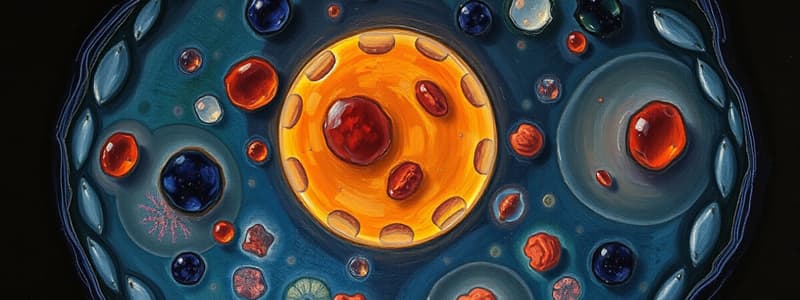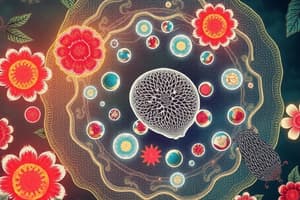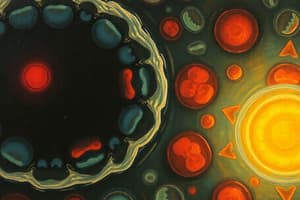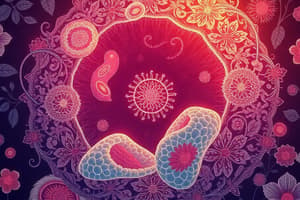Podcast
Questions and Answers
What is the primary cause of infection in humans associated with E. coli?
What is the primary cause of infection in humans associated with E. coli?
- Chronic disease
- Tuberculosis
- Upper respiratory infection
- Food poisoning (correct)
How long does it typically take for Mycobacterium to double in number?
How long does it typically take for Mycobacterium to double in number?
- 1 hour
- 12 hours
- 24 hours (correct)
- 20 mins
Which of the following factors is NOT mentioned as impacting the growth of bacteria?
Which of the following factors is NOT mentioned as impacting the growth of bacteria?
- Oxygen requirements
- Temperature
- Nutrients
- Humidity (correct)
Which type of bacteria requires complex nutrients for growth?
Which type of bacteria requires complex nutrients for growth?
What is one of the major nutrients bacteria need for growth?
What is one of the major nutrients bacteria need for growth?
Which type of bacteria primarily uses organic carbon for energy?
Which type of bacteria primarily uses organic carbon for energy?
What is a characteristic of non-fastidious bacteria?
What is a characteristic of non-fastidious bacteria?
Which of these elements is NOT typically classified as a necessary nutrient for bacterial growth?
Which of these elements is NOT typically classified as a necessary nutrient for bacterial growth?
Which disease is transmitted by Anopheles mosquitoes?
Which disease is transmitted by Anopheles mosquitoes?
What is the primary reservoir for the Zika virus?
What is the primary reservoir for the Zika virus?
Which organism is responsible for causing scabies?
Which organism is responsible for causing scabies?
In the case study, how was the large lesion initially treated?
In the case study, how was the large lesion initially treated?
What is the recommended practice for preventing the spread of scabies?
What is the recommended practice for preventing the spread of scabies?
Which disease is primarily spread by ticks?
Which disease is primarily spread by ticks?
Which of the following statements is true regarding the transmission of the Zika virus?
Which of the following statements is true regarding the transmission of the Zika virus?
Which of the following best defines the importance of understanding transmission in disease prevention?
Which of the following best defines the importance of understanding transmission in disease prevention?
What process do bacteria primarily use for reproduction?
What process do bacteria primarily use for reproduction?
Which bacterial shape is characterized as rod-shaped?
Which bacterial shape is characterized as rod-shaped?
What is the function of pili in bacterial cells?
What is the function of pili in bacterial cells?
What role do endospores play in bacteria?
What role do endospores play in bacteria?
Which component of the bacterial cell wall is a target for specific antibiotics?
Which component of the bacterial cell wall is a target for specific antibiotics?
What distinguishes Gram-positive bacteria from Gram-negative bacteria?
What distinguishes Gram-positive bacteria from Gram-negative bacteria?
What is the primary function of the glycocalyx in bacteria?
What is the primary function of the glycocalyx in bacteria?
Which structure is primarily involved in bacterial movement?
Which structure is primarily involved in bacterial movement?
What is contained within the nucleoid of a bacterial cell?
What is contained within the nucleoid of a bacterial cell?
Which of the following is NOT a component of the bacterial cell wall?
Which of the following is NOT a component of the bacterial cell wall?
What substance can be found in a bacterial capsule?
What substance can be found in a bacterial capsule?
What is the main function of the cytoplasmic membrane in bacteria?
What is the main function of the cytoplasmic membrane in bacteria?
What is the function of the slime layer in bacteria?
What is the function of the slime layer in bacteria?
What is true about mycoplasma bacteria?
What is true about mycoplasma bacteria?
What process describes the internalization of a prokaryotic cell by an ancient Archaea to form organelles?
What process describes the internalization of a prokaryotic cell by an ancient Archaea to form organelles?
Which cellular structures are primarily associated with photosynthetic eukaryotes?
Which cellular structures are primarily associated with photosynthetic eukaryotes?
What is the primary basis for classifying cells into the three domains of life?
What is the primary basis for classifying cells into the three domains of life?
What is a type strain?
What is a type strain?
Which of the following represents the correct format for binomial classification?
Which of the following represents the correct format for binomial classification?
In relation to the universal tree of life, which term refers to the evolutionary history of cells?
In relation to the universal tree of life, which term refers to the evolutionary history of cells?
What distinguishes prokaryotes from eukaryotes?
What distinguishes prokaryotes from eukaryotes?
Which organelle is involved in energy production within eukaryotic cells?
Which organelle is involved in energy production within eukaryotic cells?
What is the main characteristic of aerosol transmission?
What is the main characteristic of aerosol transmission?
Which of the following best describes droplet transmission?
Which of the following best describes droplet transmission?
Which mode of transmission involves physical contact between people?
Which mode of transmission involves physical contact between people?
What type of transmission occurs through fomites?
What type of transmission occurs through fomites?
What is required for vector-borne transmission to occur effectively?
What is required for vector-borne transmission to occur effectively?
Which of the following factors affect the survival time of microorganisms in the air?
Which of the following factors affect the survival time of microorganisms in the air?
How can transmission of Bordetella pertussis occur?
How can transmission of Bordetella pertussis occur?
What distinguishes indirect contact transmission from direct contact transmission?
What distinguishes indirect contact transmission from direct contact transmission?
Which of the following is NOT a common vector for transmission?
Which of the following is NOT a common vector for transmission?
Which of the following scenarios represents vector-borne transmission?
Which of the following scenarios represents vector-borne transmission?
Flashcards are hidden until you start studying
Study Notes
Cell Structure and Classification
- Eukaryotic cells contain organelles such as the nucleus, mitochondria, and chloroplasts (in plants).
- Plant cells have a distinct cell wall, differing from animal cells.
Prokaryotic and Eukaryotic Development
- Prokaryotes played a critical role in the evolution of eukaryotes through a process called endosymbiosis.
- Endosymbiosis involves a prokaryotic cell's internalization by an ancient Archaea, resulting in mitochondria and chloroplasts found in eukaryotic organisms.
Universal Tree of Life
- Cells can be classified into three domains based on ribosomal RNA genes, depicting evolutionary relationships.
- This classification method is applicable across all biological lineages.
Binomial Classification
- Species are identified using the binomial nomenclature system, consisting of the genus and species name (e.g., Pseudomonas aeruginosa).
- Further classifications within a species can be made using distinct strains, with a "type strain" representing typical characteristics.
Bacterial Reproduction
- Bacteria reproduce asexually via binary fission, which involves DNA replication and subsequent cell division into identical daughter cells.
Bacterial Cell Shapes
- Bacterial shapes include:
- Cocci (spherical) – e.g., Staphylococcus aureus (causes boils, food poisoning).
- Bacilli (rod-shaped) – e.g., Salmonella enterica (causes gastroenteritis).
- Spirilla (spiral) – e.g., Treponema pallidum (causes syphilis).
- Some bacteria lack a defined shape due to no cell wall – e.g., Chlamydia trachomatis (causes chlamydia).
Surface Structures of Bacteria
- Flagella enable locomotion and may function as sensory organelles.
- Pili/Fimbriae assist in adhesion and bacterial conjugation.
- Capsules act as virulence factors, protecting against phagocytosis.
- Slime layers aid in adherence within biofilms.
Cytoplasmic Structures in Bacteria
- The nucleoid contains chromosomal DNA.
- Inclusions serve various functions, while ribosomes are vital for protein synthesis.
- Plasmids are extrachromosomal DNA that play roles in pathogenicity and antibiotic resistance.
Endospores
- Endospores form in unfavorable conditions and act as "resting cells."
- They have a robust spore coat that ensures bacterial survival against extreme environmental stressors.
Bacterial Cell Wall and Gram Staining
- The cell envelope consists of the cytoplasmic membrane, cell wall, and an outer membrane in Gram-negative bacteria.
- The cell wall maintains structural integrity and aids in bacterial classification (Gram-positive vs. Gram-negative).
- Not all bacteria possess a cell wall, such as Mycoplasma.
Peptidoglycan Structure
- Peptidoglycan is a crucial component of bacterial cell walls, comprising alternating sugar chains (NAG and NAM) cross-linked by peptides.
- This structure is targeted by certain antibiotics and is considered a virulence factor.
Gram-Positive and Gram-Negative Bacteria
- Gram-positive bacteria possess a thick peptidoglycan layer (20-80 nm) and lack an outer membrane; they contain teichoic acids.
- Gram-negative bacteria have a thin peptidoglycan layer and an outer lipid membrane composed of lipopolysaccharides.
Factors Affecting Bacterial Growth
- Environmental factors influencing bacterial growth include temperature, pH, oxygen levels, nutrients, and water activity.
- Essential nutrients for bacterial life include carbon, nitrogen, sulfur, potassium, phosphorus, magnesium, oxygen, and calcium.
- Bacteria can be classified as heterotrophs (organic carbon users) or autotrophs (CO2 users). Some bacteria are non-fastidious, growing easily in basic media, while others are fastidious and require additional nutrients.### Modes of Transmission of Bordetella pertussis
- Microorganisms survive in air; however, many do not grow in air.
- Survival rates depend on factors like organism strength, temperature, UV exposure, humidity, and mucous encasement.
Transmission Sources
- Transmission can occur from humans, animals, food, soil, or water.
- Pathogens can spread through evaporation or disturbance of environments.
Aerosol Transmission
- Involves pathogen-laden droplet nuclei measuring 1-4 µm.
- Small droplets can travel over distances greater than 1 meter.
- Main sources include coughing, sneezing, and speaking.
- Surgical masks are not always effective against small droplet transmission.
Droplet Transmission
- Larger droplets (> 5 µm) are released and impacted more by gravity.
- These droplets travel shorter distances, generally less than 1 meter.
- Surgical masks are more effective in containing larger droplet transmission.
Contact Transmission
- Occurs through direct or indirect contact with a pathogen source.
- Direct contact includes person-to-person interactions (touch, kissing, sexual contact) and mother-to-infant contact during childbirth.
- Indirect contact involves transmission via contaminated inanimate objects (fomites), such as shared utensils, bedding, or water sources.
Vector-Borne Transmission
- Involves living transmitters (vectors) crucial to the transmission cycle.
- Most vectors are arthropods (insects) like fleas, mites, ticks, and mosquitoes.
- Examples include human malaria transmission via mosquitoes and bubonic plague transmission via rat fleas.
- Vertebrates can also serve as vectors; for instance, Hendra virus transmission involves bats, horses, and humans.
Notable Vector-Borne Diseases
- Mosquitoes transmit diseases including Yellow fever, Zika virus, Dengue fever, and Chikungunya.
- Ticks are responsible for Lyme disease.
- Rat fleas are vectors for the bubonic plague.
- Fruit bats transmit Hendra disease to horses and then to humans.
Importance of Understanding Transmission
- Knowledge of transmission methods is vital for disease prevention efforts.
- Case study illustrates the importance of understanding transmission routes: a patient diagnosed with a fungal infection and suspected scabies prompted thorough cleaning measures for all potentially contaminated items.
Studying That Suits You
Use AI to generate personalized quizzes and flashcards to suit your learning preferences.





